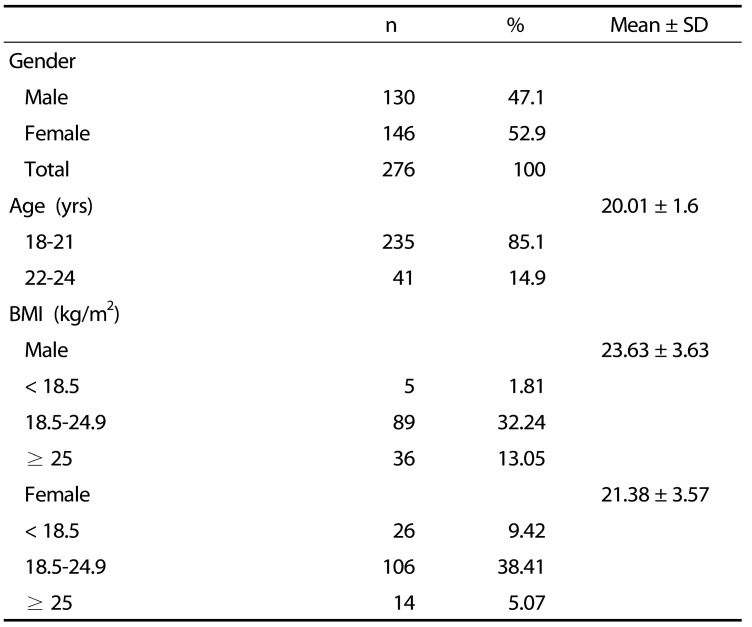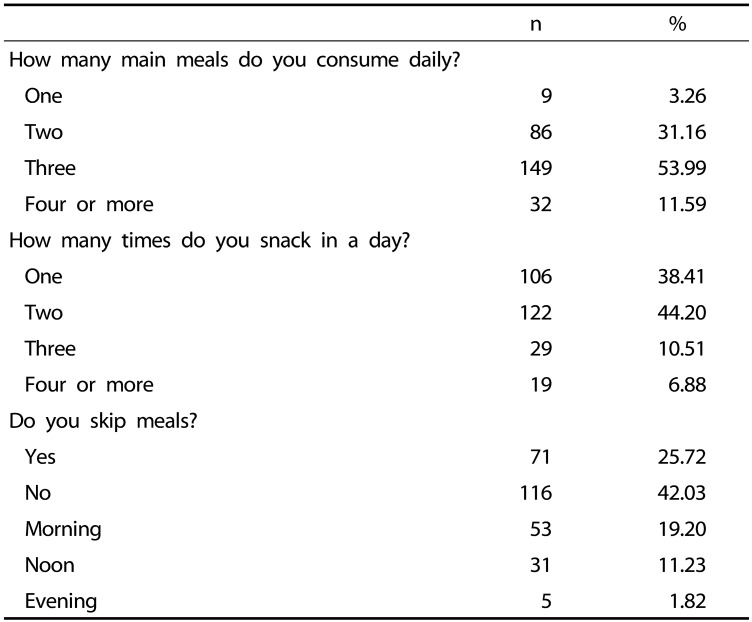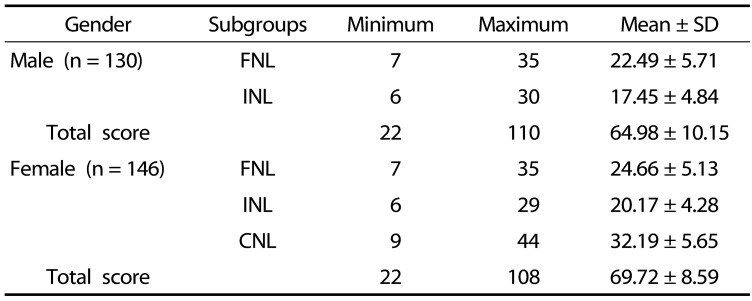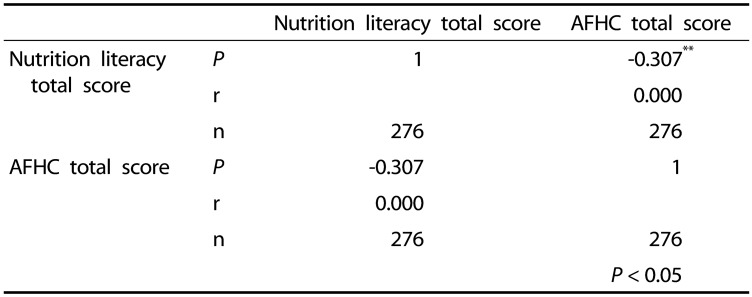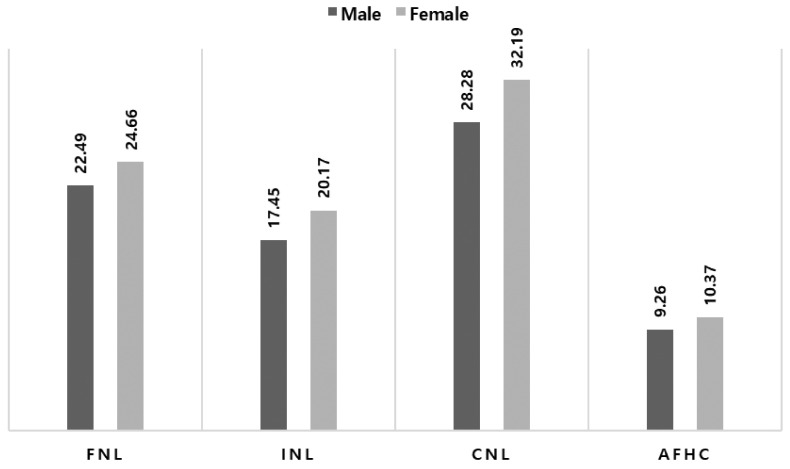Abstract
BACKGROUND/OBJECTIVES
Youth is the crucial stage between childhood and adulthood during which an individual acquires new behavior and practices including dietary habits, that may be influenced by his peers, social circle, nutrition knowledge level and other factors. The increase in awareness of young adults is of special importance from the perspective of health and prevention of obesity related chronic diseases. To measure the nutrition literacy level of university students using the Turkish version of Adolescent Nutrition Literacy Scale (ANLS). We evaluated their food habits using the Adolescent Food Habit Checklist (AFHC) tool and analysed it, if the eating habits were affected by nutrition literacy level.
SUBJECTS/METHODS
A cross-sectional descriptive study was conducted on randomly selected 276 students studying in the Faculty of Health Sciences of Istanbul Aydin University, Turkey. Data was collected by means of ANLS and AFHC tools by face to face interview method. SPSS statistical sofware (IBM SPSS Statistics 19) was used to analyse the obtained data.
RESULTS
Participants comprised of 47.1% males and 52.9% females with mean age of 20.0 ± 1.60 years. Mean body mass index (BMI) was determined as 22.4 ± 3.76 (23.6 ± 3.63 males 21.3 ± 3.57 females). Functional, interactive and critical nutritional literacy scores for male participants were 22.49 ± 5.71, 17.45 ± 4.84, and 28.28 ± 7.13 respectively (total 64.98 ± 10.15). For females the values were 24.66 ± 5.13, 20.17 ± 4.28, and 32.20 ± 5.65 (total 69.72 ± 8.59) respectively. For all the three sub-categories of nutrition literacy, the scores acquired by females were significantly higher than males (P < 0.001). In the AFHC tool, the mean score acquired by males were 9.26 ± 4.18 whereas for females it was 10.37 ± 3.40 significantly higher as compared to males (P = 0.007).
CONCLUSIONS
The food habits of female participants were better than males; in accordance with their nutrition literacy status. It may be concluded that food habits are influenced by nutrition literacy and therefore stress much be given to increase the nutrition awareness among children youth as well as adults.
Keywords: Young adults, youth, food habits, obesity, nutrition literacy
INTRODUCTION
Youth is a transitory phase from childhood to adulthood exhibiting rapid changes in physical growth, psychosocial development, and behavioral modifications. Several habits including eating behaviors adopted during this age may continue throughout life in most individuals [1,2]. Energy and nutrient requirements are high in young adults due to rapid physical growth as well as pubertal and cognitive development. Inadequate macro and micro-nutrient intake, unhealthy eating habits, peer influence, and other unfavourable factors cause young adults to be among one of the nutritionally vulnerable groups [3,4]. Furthermore, lack of knowledge of healthy food choices in young adults and children also lead to embracement of unhealthy food habits, adversely affecting their health and nutritional status [2,5,6].
In this context, “food or nutrition literacy” terms can be encountered upon frequently [7,8,9]. Food literacy has been defined as the ability to basically understand the nature of food and its importance, gain information about food, process it, analyse it and act upon it [8]. On the other hand, “Nutrition literacy” may be defined as the extent to which individuals possess the ability to obtain, comprehend and adopt basic nutrition concepts and information [10]. Nutrition literacy may be categorized as, functional, interactive, and critical nutrition literacy [11]. Functional nutrition literacy (FNL) may be identified as the capacity of an individual to understand and comprehend nutritional concepts and messages. Interactive nutrition literacy (INL) may be described as the cognitive skills required to deal with nutritional issues while interacting with partners, professionals, and affiliated shareholders. Critical nutrition literacy (CNL) may be defined as the capacity of an individual to evaluate nutrition information critically, raise awareness among peers and social circle as well as be active in addressing nutritional issues and barriers [10,11].
Studies performed on young adults worldwide and Turkey indicate a rising prevalence in obesity and high energy intake [12,13]. In a meta-analysis study on obesity prevalence in Turkish children and young adults conducted by Alper et al. [13], it was reported that obesity prevalence increased from 0.6% to 7.3% with an 11.6-fold increase between the periods 1990-1995 to 2011–2015. Although the prevalence increased in both gender, boys were more likely to be obese than girls [13]. In another study conducted by Gokler et al. [14] comparing the obesity prevalence in young adults in rural and urban areas and associated cardiovascular risk factors; it was reported that the prevalence of being overweight was 10.4% and 12.2% and the prevalence of obesity was 7.9% and 11.3% in rural and urban areas, respectively. A study assessing dietary habits of 643 Turkish young adults using Adolescent Food Habit Checklist (AFHC) by Kalkan et al. [15] in 2015 indicated a dietary level lower than optimal standards. Another survey conducted by Akman et al. [16] regarding the eating patterns of Turkish adolescent students aged 11–15 years reported that less than 2% met all the recommendation of the Food Guide Pyramid.
This study was performed with the objective of measuring the nutrition literacy level and eating habits of university students, studying in the Faculty of Health Sciences. Turkish versions of Adolescent Nutrition Literacy Scale (ANLS) [1] and Adolescent Food Habit Checklist (AFHC) [17] were used to evaluate their nutrition literacy and food habits respectively. The researchers aimed to analyse if the food habits of the individuals were affected by their nutrition literacy levels.
SUBJECTS AND METHODS
Study participants
This study was conducted on 276 students studying in the Faculty of Health Sciences of Istanbul Aydin University, Turkey between September 2016 and February 2017. Care was taken to enable a uniform distribution with respect to the students' gender and fields of study (Nutrition and Dietetics, Nursing, Physiotherapy, Health management, Social Services, Child Development, Odiology). The total population of students enrolled in the Faculty of Health Sciences in the academic year 2016–2017 were 1,100 approximately. The experimental sample was calculated to be 276 according to stratified sampling method (confidence level 95%, margin of error 5%). The participants were selected on a random basis after taking their voluntary approval.
Data collection
Data was collected by means of ANLS [1] and AFHC [17] tools. There were also 11 general questions prepared by the researchers based on literature review which were related to demographic characteristics of the individuals and information as consumption of bevarages, number of meals taken, and types of snacks consumed. The participants were also asked if they engaged in any physical activity on a routine basis and if they did, which sports did they engage themselves in.
Adolescent nutrition literacy scale (ANLS)
ANLS developed by Bari in 2012 [11] and validated in Turkish language by Turkmen et al. [1] 2017, aimed to measure nutrition literacy status of young adults. The original tool comprised of 29 items in total under three sub-headings. Functional Nutrition Literacy (FNL) having 9 items followed by Interactive Nutrition Literacy (INL) with 9 items and finally Critical Nutrition Literacy (CNL) consisting of 11 items. FNL indicated the individual's knowledge and follow up of literature in the field of nutrition. INL indicated the individual's application of nutrition knowledge in practical life and CNL reflected his/her tendency to participate and take active role in nutrition related topics. Every item was scored between 1–5 on a “5 point likert type scale” (1 = strongly disagree, 2 = disagree, 3 = neutral, 4 = agree, 5 = strongly agree). Regarding the adaptation of the scale in Turkish language, the scale was translated from English to Turkish using the backtranslation technique. The scale comprising of 22 items were applied to 474 high school students. Results obtained by factor analyses adminstered to validate the content of the scale, were very similar to the original ANLS scale. Factors with Eigenvalue more than 1.0 were taken into consideration and three factors were specified accordingly. Items with factor weights less than 0.30 were not included in the scale [1]. Two items from FNL, 3 items from INL and 2 items from CNL were eliminated from the validated tool, having factor weights of 0.3 or lower. Therefore, validated tool comprised of 7 FNL, INL, and 9 CNL items (22 items in total). Maximum and minimum scores to be attained from FNL section was 35 and 7 respectively. From INL, maximum 30 and minimum 6 could be attained and from CNL, maximum and minimum scores to be attained was 45 and 9 respectively [1,11].
Adolescent food habits checklist (AFHC)
Adolescent Food Habits Checklist (AFHC) developed by Johnson et al. [18] 2002 and validated in Turkish language by Arikan et al. [17] 2012, was aimed at measuring healthy eating behavior of young adults between 13–16 years of age. However, this tool has been used in another study with 2,300 participants upto 18 years of age aimed to determine the prevalence of acne and relationship with dietary habits in Eskisehir Turkey. In this study mean age of the participants were very close to adolescence (20.01 ± 1.6 years) and therefore AFHC tool was selected to study their food habits [19]. The original questionnaire comprised of 23 items, four of which were eliminated from the Turkish version due to low inter-item correlation (< 0.2). The final AFHC questionnaire consisted of 19 items evaluating consumption of fats (6 items), sugars (6 items), fruits and vegetables (6 items), carbohydrates/ fast-food (2 items) and daily diet in general (1 item). The inter-item correlation between these 19 items were between 0.21–0.46.
As for the AFHC questionnaire, a positive / negative (Yes/No) response format was selected to make the checklist easier to complete. Participants were granted one point for each ‘healthy’ response. Maximum score to be attained by the Turkish version of AFHC instrument was determined to be 19. Procurement of a high score by the students demonstrated healthy eating habits on the part of the individual [17].
The study was conducted by the authors who are academic faculty members of the Nutrition and Dietetics Department at Istanbul Aydin University through face to face interview method with the participants in the classrooms.
Statistical analysis
The obtained data was analysed by using the Statistical Package for Social Science (SPSS) IBM 19 Statistics packet Program. Descriptive statistics methods were used to calculate the arithmetic mean (χ), standard deviations (SD), maximum, and mininum values. ANOVA was used to evaluate the mean nutrition literacy scores attained by male and female participants. The AFHC scores for male and female participants were evaluated by means of students independent t-test. The Pearson correlation coefficient was used to determine the correlation between nutrition literacy and the AFHC scores of the participants.
Ethical issues
Ethical approval for this study was acquired by the Istanbul Aydin University Ethical Committee dated on March 08, 2017 (Document No: 54167746-050.99).
RESULTS
Characteristics of the participants
The study was conducted on 276 individuals, out of which 52.9% (n = 146) were females. 85.1% of the participants were between the age of 18–21. Mean age of the participants were calculated to be 20.01 ± 1.6 years. Among the females, 38.41% belonged to normal BMI range as compared to 32.24% males. On comparing the body mass index (BMI) between the genders, the proportion of individuals with BMI ≥ 25 were found to be significantly higher (P < 0.05) in males (13.05%) as compared to females (5.07%) as shown in Table 1.
Table 1. Demographic characteristics of the participants (n = 276).
Consumption of meals and snacking habits
Mean BMI for males (23.63 ± 3.63) were also significantly higher than females (21.38 ± 3.57) (P < 0.05).
The participants were asked about their snacking habits and skipping of main meals during a day. As per their responses, 25.72% of the participants skipped meals. Furthermore, 31.16% consumed only two main meals and 44.20% snacked twice in a day as shown in Table 2.
Table 2. Consumption of meals and snacking habits of the participants (n = 276).
Nutrition literacy scores acquired
The participants were asked for their preference regarding snack items and also the type of beverages they consumed on a daily basis. The most popular beverage was water (80.9%) followed by tea (68.9%) and coffee (62.9%). Among the total participants, 94% stated that they consumed tea or coffee on a regular basis. In addition, 53% of the regular tea or coffee drinkers consumed upto 200 mL, 32.6% consumed 300 mL, 14.4% consumed 400 mL or more tea and/or coffee in a day. On inquiring about the consumption of sugary beverages, 74.0 % of students stated that they consumed such beverages on a regular basis. Of the regular consumers, 55% consumed up to 200 mL, 29.7% consumed 400 mL and 15.3% consumed more than 400 mL of sugary beverages in a day. Among the snacks, the most popular item was chocolate (67.8%) followed by cookies (48.4%). Considering the increasing obesity prevalence among young adults and adults in Turkey, it was worthwhile to note that only 25.1% of the participants stated to have been engaged in regular sports activities. The Nutrition literacy mean scores as well as the maximum and minimum scores attained by the participants under the sub-headings of Functional Nutrition Literacy (FNL), Interactive Nutrition Literacy (INL) and Critical Nutrition Literacy (CNL) have been summarized in Table 3.
Table 3. Nutrition literacy scores acquired by the participants (n = 276).
Nutrition literacy scores
On comparing the mean scores attained by male and female participants for each of the nutrition literacy subgroups by ANOVA, the scores acquired by the females were significantly higher (for FNL P = 0.001; INL P < 0.001; CNL P < 0.001) as compared to males. Each of the subgroups of nutrition literacy is related to a different aspect of the participants' knowledge and approach towards nutrition. Correlation between the scores achieved by the participants in different subgroups of nutrition literacy were analysed by the Pearson correlation test. Correlation was found to be significant (P = 0.01) between FNL and CNL (r = 0.309) as well as INL and FNL (P < 0.001) r = 0.391). The correlation was highest between INL and CNL (P < 0.001) r = 0.621). When the correlations were compared within each gender separately, the trends were very similar, highest correlation being exhibited between interactive and critical nutrition literacy.
Adolescent food habit
Food habits of the participants were evaluated by the Turkish version of Adolescent Food habit checklist AFHC [17]. The maximum score to be attained by the instrument was determined to be 19 since each positive (true/yes) response scored a point each. Procurement of a high score by the students demonstrated healthy eating habits on the part of the individual.
Table 4 shows the results of the AFHC responses provided by the participants. The AFHC scores obtained by the female participants in this study was significantly higher as compared to male participants (P = 0.007).
Table 4. Adolescent food habit checklist scores of participants.
Nutrition literacy and food habit
A correlation between nutrition literacy total score and AFHC score of all participants were examined. A strong positive correlation was found between the two scores (P < 0.05) (Table 5).
Table 5. Correlation between nutrition literacy total score and adolescent food habit checklist scores of participants (n = 276).
AFHC: Adolescent Food Habit Checklist.
In this study, the nutrition literacy scores in all subcategories were significantly higher in female participants as acompared to males (Table 3, Fig. 1). In the same manner, AFHC scores were also significantly higher in females than in males (Table 4, Fig. 1).
Fig. 1. Camparison of nutrition literacy and AFHC levels among males and females.
FNL, functional nutrition literacy; INL, interactive nutrition literacy; CNL, critical nutrition literacy; AFHC, adolescent food habit checklist.
DISCUSSION
This study evaluated the nutrition literacy level in a Turkish young adult population, exhibiting a growing trend in obesity, and investigated whether it had an effect on their food habits.
Although in this study the mean BMI for participants were within normal range, the proportion of BMI ≥ 25 were found to be significantly higher (P < 0.05) in males than in females. A meta- analysis study was conducted between 1990 through 2015 in respect to propensity in obesity prevalence among young adults and children in Turkey. According to the study, the prevalence of obesity increased from 0.6% to 7.3% during this time span. An 11.6-fold increase was recorded between the periods 1990–1995 to 2011–2015. Although the prevalence of obesity increased in both genders; males were found to be more likely to be obese than females [13]. Another study, reviewing prevalence of overweight and obesity in Turkish adults between 1990–2012, indicated a higher prevalence of obesity in women (from 28% to 44%) as compared to men (from 9% to 27%) although the rate of increase over the years was higher for men [20].
Popularity of tea as a beverage and chocolate as the most preferred snack item determined in this study were close to dietary habits of 643 high school students in Konya, Turkey [15]. In a study carried out on 610 university students at Sakarya University, Turkey, tea (81%) and coffee (46%) were determined to be among the most preferred beverage. Chocolate was among the most preferred snack items (58%) followed by pizza and other bakery products (40.5%) [21]. In another study investigating fast food consumption habits of 265 students at the Trakya University in Turkey, rate of fast food consumption was found to be as high as 97.4% [21]. Street foods in the form of fast foods were also suggested to be very popular among Turkish young people aged 19–22 years of age. The authors determined that 40.1% of the youth consumed street foods as Turkish bagels, döner, boiled corn in a cup and toast 2–3 times per week, whereas 23.3% consumed it every day [23].
Regarding regular physical activity of the students, as per their statements only 25.1% engaged in regular sportive or physical activity. This finding was in accordance with the World Health Organization (WHO) report, which indicated that 77.1% of male and 86.9% of female young adults in Turkey led a physically inactive lifestyle [24].
On comparing the mean scores attained by male and female participants for each of the nutrition literacy subgroups by ANOVA, the scores acquired by the females were significantly higher (for FNL P = 0.001; INL P < 0.001; CNL P < 0.001) as compared to the males (Table 3). Also, the AFHC scores obtained by the female participants in this study was significantly higher as compared to male participants (P = 0.007) (Table 4). It could be suggested therefore that food consumption habits of an individual may be affected by their nutrition literacy levels.
In another study performed by the author using the same tool on a group of high school students [15] comprising of 643 individuals; the AFHC scores were also found to be significantly higher in females (P < 0.001). Similarly, nutritional knowledge scores were found to be higher in female university students as compared to males in two other studies; one performed in 231 college students in Michigan University USA [24] and the other with 1,674 students from Gazi University in Turkey and St. Cloud University in USA [26].
Although the high AFHC scores did not show a negative correlation with body mass index; lower consumption of fast food and lesser number of meals in a day were strongly correlated with higher AFHC scores demonstrating healthy nutrition habits on the part of the females as compared to males [17]. In a study carried out on female university students studying in different departments of health sciences faculty in a university in Northern Cyprus, nutrition and dietetics students were found to have the most optimal nutrient intakes followed by nursing students as compared to students from departments in physiotherapy, health management and sports sciences [27].
Factors such as food knowledge and food preparation skills in young adults were suggested to have positive impacts on dietary intake [28,29]. However, comprehensive research on behaviour changes suggested that knowledge on its own was often not sufficient to change an individual's behaviour including his food choices. Therefore, there is a pressing need to move beyond knowledge, to more inclusive concepts such as food literacy, in order to affect changes in behaviours of interest, including dietary choices [30].
Chung performed a review study regarding food (nutrition) literacy of young adults and its effect on their healthy eating and dietary quality [31]. The author reported that nutrition literacy affected an individual's ability to evaluate information regarding food choices, perceive food labels, implement food safety precautions, apply healthy cooking methods and appropriate dietary recommendations. Therefore, he suggested that, it would be of great importance for educators to assess and enhance the nutrition literacy skills of young people [31].
In a study conducted on nutrition literacy, dietary behavior and consumer confusion regarding food choices, the authors reported that in most cases consumers were confused in making the appropriate and healthy food choices because of limited or faulty nutrition knowledge obtained from sources that lacked scientific expertise in nutrition possessed a commercial perspective rather than health-related objectives [32]. Aktas and Ozdogan have also stressed on the importance of nutrition literacy in healthy food selection, prepartion and consumption [7]. On the other hand, too much nutrition information with ambiguity may also lead to nutrition confusion in individuals with low level of nutrition knowledge. Therefore, nutrition literacy, encompassing conceptual as well as procedural knowledge [33], plays a significant role in addressing consumer confusion issues and subsequent dietary behavior.
The present study was aimed to evaluate the nutrition literacy level as well as the food habits of 276 young adults and analyse whether the eating habits were affected by their nutrition literacy level. On comparing the mean scores attained by male and female participants for each of the nutrition literacy subgroups, scores acquired by the females were significantly higher than males. Also, the AFHC scores obtained by the female participants in this study was significantly higher as compared to male participants. In addition, a strong correlation was found between nutrition literacy total score and AFHC scores of participants in general.
The findings suggested that eating behavior of individuals were indeed affected by their nutrition literacy status. Although factors such as food and nutrition knowledge, involvement in food preparation, food preparation skills, etc. can affect dietary behaviors in a positive manner. However, myriad ambiguous nutrition information through illegitimate health communication medium leads to confusion, anxiety and incorrect food choices by individuals. In this respect, consumers must possess adequate nutrition literacy level which encompasses more than just healthy eating knowledge. Youth being a crucial stage for adopting dietary habits that may continue throughout lifetime, increase in awareness of young adults regarding healthy eating and dietary quality is of special importance from the perspective of health and prevention of obesity related chronic diseases. The evidence stresses on increasing public awareness, recommends health practitioners and policy makers to consider public health strategies and regulations that focus on increasing nutrition literacy, knowledge and health awareness in the society.
Footnotes
CONFLICT OF INTEREST: The author declares no conflict of interest.
References
- 1.Türkmen AS, Kalkan I, Filiz E. Adaptation of adolescent nutrition literacy scale into Turkish: a validity and reliability study. Int Peer-Reviewed J Nutr Res. 2017;10:1–16. [Google Scholar]
- 2.Nelson MC, Story M, Larson NI, Neumark-Sztainer D, Lytle LA. Emerging adulthood and college-aged youth: an overlooked age for weight-related behavior change. Obesity (Silver Spring) 2008;16:2205–2211. doi: 10.1038/oby.2008.365. [DOI] [PubMed] [Google Scholar]
- 3.Dapi LN, Hörnell A, Janlert U, Stenlund H, Larsson C. Energy and nutrient intakes in relation to sex and socio-economic status among school adolescents in urban Cameroon, Africa. Public Health Nutr. 2011;14:904–913. doi: 10.1017/S1368980010003150. [DOI] [PubMed] [Google Scholar]
- 4.Braun M, Brown BB. Nutrition in adolescence. In: Brown BB, Prinstein MJ, editors. Encyclopedia of Adolescence. Boston: Academic Press; 2011. pp. 251–259. [Google Scholar]
- 5.Aksoydan E, Çakir N. Evaluation of nutritional behavior, physical activity level and body mass index of young adults. Gulhane Med J. 2011;53:264–270. [Google Scholar]
- 6.Aktaş N, Özdoğan Y. A study of the state of knowing the nutritional literacy concept in Turkey. Reserachers World. 2016;7:46–52. [Google Scholar]
- 7.Aktaş N, Özdoğan Y. Food and nutrition literacy. Harran J Agric Food Sci. 2016;20:146–153. [Google Scholar]
- 8.Brooks N, Begley A. Adolescent food literacy programmes: a review of the literatures. Nutr Diet. 2014;71:158–171. [Google Scholar]
- 9.Cullen T, Hatch J, Martin W, Higgins JW, Sheppard R. Food literacy: definition and framework for action. Can J Diet Pract Res. 2015;76:140–145. doi: 10.3148/cjdpr-2015-010. [DOI] [PubMed] [Google Scholar]
- 10.Velardo S. The nuances of health literacy, nutrition literacy, and food literacy. J Nutr Educ Behav. 2015;47:385–389.e1. doi: 10.1016/j.jneb.2015.04.328. [DOI] [PubMed] [Google Scholar]
- 11.Bari NN. Nutrition literacy status of adolescent students in Kampala district [master's thesis] Uganda: Oslo and Akershus University College of Applied Sciences; 2012. [Google Scholar]
- 12.Peltzer K, Pengpid S, Samuels TA, Özcan NK, Mantilla C, Rahamefy OH, Wong ML, Gasparishvili A. Prevalence of overweight/obesity and its associated factors among university students from 22 countries. Int J Environ Res Public Health. 2014;11:7425–7441. doi: 10.3390/ijerph110707425. [DOI] [PMC free article] [PubMed] [Google Scholar]
- 13.Alper Z, Ercan İ, Uncu Y. A meta-analysis and an evaluation of trends in obesity prevalence among children and young adults in Turkey: 1990 through 2015. J Clin Res Pediatr Endocrinol. 2018;10:59–67. doi: 10.4274/jcrpe.5043. [DOI] [PMC free article] [PubMed] [Google Scholar]
- 14.Gökler ME, Buğrul N, Metintaş S, Kalyoncu C. Adolescent obesity and associated cardiovascular risk factors of rural and urban life (Eskisehir, Turkey) Cent Eur J Public Health. 2015;23:20–25. doi: 10.21101/cejph.a3958. [DOI] [PubMed] [Google Scholar]
- 15.Kalkan I, Turkmen AS, Filiz E. Dietary habits of Turkish young adults in Konya, Turkey. Glob J Adv Pure Appl Sci. 2015;7:190–196. [Google Scholar]
- 16.Akman M, Akan H, Izbirak G, Tanriöver Ö, Tilev SM, Yildiz A, Tektaş S, Vitrinel A, Hayran O. Eating patterns of Turkish adolescents: a cross-sectional survey. Nutr J. 2010;9:67–71. doi: 10.1186/1475-2891-9-67. [DOI] [PMC free article] [PubMed] [Google Scholar]
- 17.Arikan I, Aksu AE, Metintas S, Kalyoncu C. The adaptation of the adolescent food habits checklist to Turkish young adults. TAF Rev Med Bull. 2012;11:49–56. [Google Scholar]
- 18.Johnson F, Wardle J, Griffith J. The adolescent food habits checklist: reliability and validity of a measure of healthy eating behaviour in adolescents. Eur J Clin Nutr. 2002;56:644–649. doi: 10.1038/sj.ejcn.1601371. [DOI] [PubMed] [Google Scholar]
- 19.Aksu AE, Metintaş S, Saraçoğlu ZN, Gürel G, Sabuncu I, Arikan I, Kalyoncu C. Acne: prevalence and relationship with dietary habits in Eskisehir, Turkey. J Eur Acad Dermatol Venereol. 2012;26:1503–1509. doi: 10.1111/j.1468-3083.2011.04329.x. [DOI] [PubMed] [Google Scholar]
- 20.Erem C. Prevalence of overweight and obesity in Turkey. IJC Metab Endocr. 2015;8:38–41. [Google Scholar]
- 21.Işkın M, Sarıışık M. A research on food consumption in students. J Turkish Tour Res. 2017;1:33–42. [Google Scholar]
- 22.Onurlubaş E, Yılmaz N. Fast food consumption habits of nutrition students. J Food Agric Environ. 2013;11:12–14. [Google Scholar]
- 23.Şanlıer N, Sezgin AC, Şahin G, Yassıbaş E. A study about the young consumers' consumption behaviors of street foods. Cien Saude Colet. 2018;23:1647–1656. doi: 10.1590/1413-81232018235.17392016. [DOI] [PubMed] [Google Scholar]
- 24.Yıldızer G, Bilgin E, Korur EN, Novak D, Demirhan G. The association of various social capital indicators and physical activity participation among Turkish adolescents. J Sport Health Sci. 2018;7:27–33. doi: 10.1016/j.jshs.2017.10.008. [DOI] [PMC free article] [PubMed] [Google Scholar]
- 25.Yahia N, Brown CA, Rapley M, Chung M. Level of nutrition knowledge and its association with fat consumption among college students. BMC Public Health. 2016;16:1047–1056. doi: 10.1186/s12889-016-3728-z. [DOI] [PMC free article] [PubMed] [Google Scholar]
- 26.Özgen L. Nutritional knowledge, attitudes and practices among university students in Turkey and the US. Anthropologist. 2016;26:158–166. [Google Scholar]
- 27.Durmaz C, Gezer C. The evaluation of food consumption status and nutrition habits of female students educated in the field of health sciences. Int Peer-Reviewed J Nutr Res. 2019;15:1–6. [Google Scholar]
- 28.da Rocha Leal FM, de Oliveira BM, Pereira SS. Relationship between cooking habits and skills and Mediterranean diet in a sample of Portuguese young adults. Perspect Public Health. 2011;131:283–287. [Google Scholar]
- 29.Laska MN, Larson NI, Neumark-Sztainer D, Story M. Does involvement in food preparation track from adolescence to young adulthood and is it associated with better dietary quality? Findings from a 10-year longitudinal study. Public Health Nutr. 2012;15:1150–1158. doi: 10.1017/S1368980011003004. [DOI] [PMC free article] [PubMed] [Google Scholar]
- 30.Vaitkeviciute R, Ball LE, Harris N. The relationship between food literacy and dietary intake in adolescents: a systematic review. Public Health Nutr. 2015;18:649–658. doi: 10.1017/S1368980014000962. [DOI] [PMC free article] [PubMed] [Google Scholar]
- 31.Chung LM. Food literacy of young adults as a predictor of their healthy eating and dietary quality. J Child Adolesc Behav. 2017;5:e117 [Google Scholar]
- 32.Spiteri Cornish LS, Moraes C. The impact of consumer confusion on nutrition literacy and subsequent dietary behavior. Psychol Mark. 2015;32:558–574. [Google Scholar]
- 33.Block LG, Grier SA, Childers TL, Davis B, Ebert JE, Kumanyika S, Laczniak RN, Machin JE, Motely CM, Peracchio L, Pettigrew S, Scott M, Bieshaar MN. From nutrients to nurturance: a conceptual introduction to food well-being. J Pub Pol & Marketing. 2011;30:5–13. [Google Scholar]



